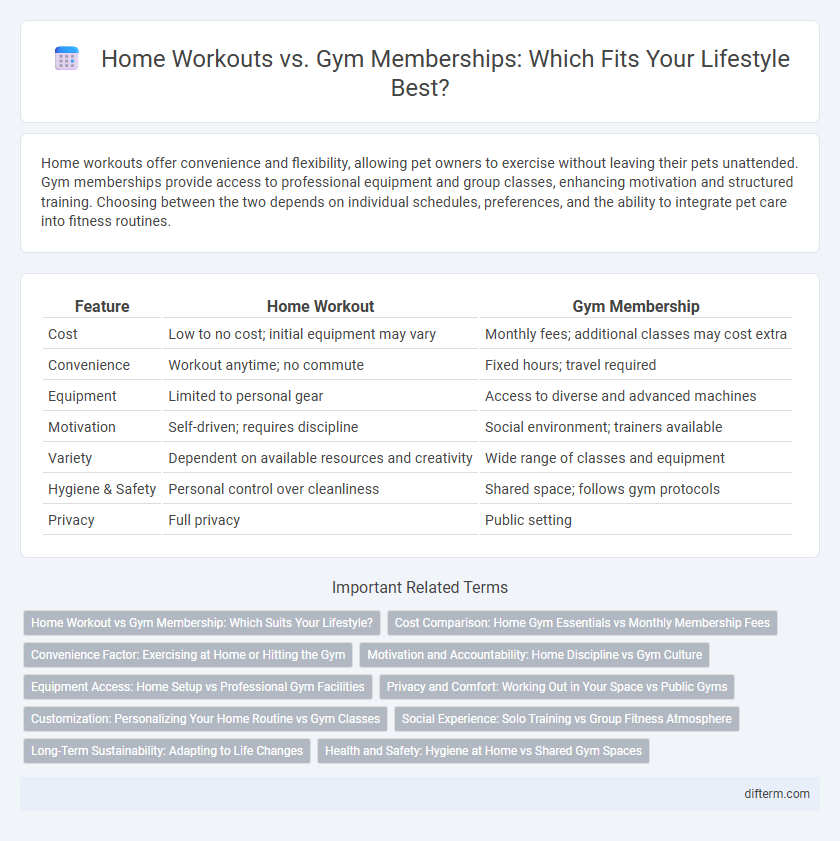Home workouts offer convenience and flexibility, allowing pet owners to exercise without leaving their pets unattended. Gym memberships provide access to professional equipment and group classes, enhancing motivation and structured training. Choosing between the two depends on individual schedules, preferences, and the ability to integrate pet care into fitness routines.
Table of Comparison
| Feature | Home Workout | Gym Membership |
|---|---|---|
| Cost | Low to no cost; initial equipment may vary | Monthly fees; additional classes may cost extra |
| Convenience | Workout anytime; no commute | Fixed hours; travel required |
| Equipment | Limited to personal gear | Access to diverse and advanced machines |
| Motivation | Self-driven; requires discipline | Social environment; trainers available |
| Variety | Dependent on available resources and creativity | Wide range of classes and equipment |
| Hygiene & Safety | Personal control over cleanliness | Shared space; follows gym protocols |
| Privacy | Full privacy | Public setting |
Home Workout vs Gym Membership: Which Suits Your Lifestyle?
Home workouts offer flexibility and cost savings by eliminating travel time and monthly fees, making them ideal for busy schedules and budget-conscious individuals. Gym memberships provide access to specialized equipment, classes, and social motivation, benefiting those who thrive in structured environments. Choosing between home workouts and gym memberships depends on personal goals, preferences, and lifestyle demands.
Cost Comparison: Home Gym Essentials vs Monthly Membership Fees
Home workout setups require an initial investment in equipment such as dumbbells, resistance bands, and yoga mats, typically costing between $200 and $600, which becomes more cost-effective over time compared to monthly gym membership fees ranging from $30 to $100. While gym memberships offer access to diverse machines and classes, recurring payments can accumulate to over $1,200 annually, making home gyms a budget-friendly alternative for long-term fitness adherence. Evaluating cost efficiency depends on workout frequency and preference, with home gyms delivering a substantial return on investment as equipment lifespan often exceeds several years.
Convenience Factor: Exercising at Home or Hitting the Gym
Home workouts offer unmatched convenience by eliminating travel time and allowing flexible scheduling that fits any lifestyle, while gym memberships provide access to diverse equipment and professional trainers in a dedicated environment. Many individuals find the convenience of home exercise, combined with digital fitness apps and virtual classes, supports consistency and time management effectively. Conversely, gyms cater to those who prefer structured routines and social motivation, enhancing workout commitment despite the need to allocate time for commuting.
Motivation and Accountability: Home Discipline vs Gym Culture
Home workouts require strong self-discipline and intrinsic motivation to maintain consistency without external accountability, making personal goal-setting crucial. Gym memberships foster motivation through social interaction, peer encouragement, and structured classes, creating an environment that enhances accountability. Choosing between home exercise and gym attendance depends on one's preference for independent routine management or community-driven support systems.
Equipment Access: Home Setup vs Professional Gym Facilities
Home workout setups often include essential equipment like adjustable dumbbells, resistance bands, and yoga mats, offering convenience and cost savings. Professional gyms provide a wider range of specialized machines, free weights, and cardio equipment that cater to diverse training goals and intensity levels. Access to advanced facilities such as swimming pools, saunas, and group classes makes gyms ideal for comprehensive fitness routines.
Privacy and Comfort: Working Out in Your Space vs Public Gyms
Home workouts provide unmatched privacy and personalized comfort, allowing individuals to exercise without distractions or self-consciousness often experienced in public gyms. The controlled environment of a home gym eliminates concerns over hygiene and overcrowding, ensuring workouts can be tailored to personal preferences and schedules. Conversely, gym memberships offer social opportunities but may compromise privacy due to shared spaces and limited solo focus.
Customization: Personalizing Your Home Routine vs Gym Classes
Home workouts offer unparalleled customization, allowing individuals to tailor exercise routines to specific fitness goals, preferences, and schedules without relying on fixed gym class times. Gym memberships provide structured classes led by professional trainers, offering guided workouts and social interaction but with less flexibility in adjusting intensity or focus on personal needs. Personalized home routines enhance adaptability and privacy, while gym classes foster motivation and expert-led instruction within a community setting.
Social Experience: Solo Training vs Group Fitness Atmosphere
Home workouts offer the advantage of personalized, distraction-free solo training, allowing individuals to focus on specific fitness goals without external pressure. Gym memberships provide a dynamic group fitness atmosphere that fosters social interaction, motivation, and a sense of community through group classes and shared spaces. Choosing between the two depends on whether you prioritize solitary concentration or the motivational benefits of social engagement during exercise.
Long-Term Sustainability: Adapting to Life Changes
Home workouts offer flexible routines that easily adapt to changing schedules and environments, promoting consistent exercise habits over time. Gym memberships provide access to diverse equipment and professional guidance, but may be limited by location, cost, and time constraints affecting long-term adherence. Prioritizing sustainability involves evaluating personal lifestyle shifts, financial commitment, and motivation to ensure fitness goals remain achievable regardless of life changes.
Health and Safety: Hygiene at Home vs Shared Gym Spaces
Home workouts offer greater control over hygiene, minimizing exposure to germs by using personal equipment in a sanitized environment. Shared gym spaces pose higher risks of cross-contamination due to multiple users touching equipment, increasing the need for stringent cleaning protocols. Emphasizing regular disinfection and personal hygiene practices is essential to maintain health and safety in both settings.
Home Workout vs Gym Membership Infographic

 difterm.com
difterm.com